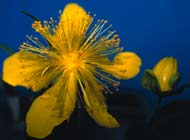![]()

Hypericum calycinum flower and bud as seen by the human eye.
Photo: Thomas Eisner/Cornell
Home Page
and index of current stories
Older stories on Resources News
Links to general resource, environmental sites
Links to non-profit environmental/resource groups
Links to environmental/resource news sources
E-mail Resources News
All In the Eye of the Beholder
Flowers just don't look the same to insects as they do to humans. When some insects zero in on a flower for nectar, their ultraviolet vision is guided by a bull's-eye "painted" on the plant by chemical compounds. Now, chemical ecologists at Cornell University have discovered a second job for these compounds - warding off herbivores.
Even before a flower bud, such as the creeping St. John's wort, opens, the same chemicals, called DIPs (for dearomatized isoprenylated phloroglucinols), are both coloring the flower in patterns unrecognizable to the human eye, and protecting the plant's reproductive apparatus by killing or deterring caterpillars. An anti-feedant chemical discourages herbivorous insects and can harm those that don't get the message.
Thomas Eisner, Cornell's Schurman Professor of Chemical Ecology, suspected that DIPs and similar compounds might have an anti-feedant function. He was led to this belief partly because the compounds are particularly prevalent in plant ovary walls - making up as much as one fifth by dry weight - as well as in other reproductive structures such as the anthers.
The flowering plant chosen for the study was Hypericum calycinum, a native of southeastern Europe that is popular with gardeners worldwide as an ornamental. When these flowers are fully open, they appear to humans as a uniform yellow disk. But to insects with ultraviolet-sensitive eyes, the disk is highlighted by a dark, ultraviolet-absorbing center, giving the flower a bull's-eye.
The experiments showed that DIPs contribute to both the ultraviolet pattern in flowers and serve as an anti-feedant.
"With the same chemical," says Eisner, "the plant is saying to pollinating insects that it needs to attract, 'this bud's for you,' and to herbivores that pose a threat, 'bug off.' Now that we know where to look, anti-feedant chemicals like DIPs undoubtedly will be found in other plant species, and they offer clues to more natural insect control agents."